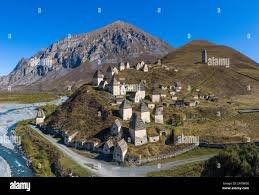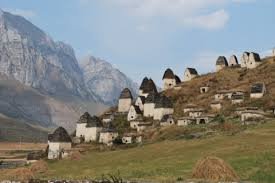Hidden in a remote valley of North Ossetia-Alania, the ghostly village of Dargavs has earned its ominous nickname as the “City of the Dead.” This abandoned settlement contains nearly 100 ancient stone crypts, many still housing the mummified remains of generations past. Dating back to the 14th century, the necropolis clings to a steep mountainside, its slate-roofed vaults silently watching over the deserted valley below. Local Ossetian legends warn that spirits guard the tombs, punishing those who disrespect the dead. The site’s isolation, combined with its remarkably preserved state and eerie atmosphere, makes it one of the Caucasus region’s most fascinating and spine-chilling destinations. Visitors brave enough to make the difficult journey often report an overwhelming sense of being watched, while some claim to hear whispers emanating from the sealed crypts.
The Origins of Ossetia’s Valley of Dargavs Death
The Dargavs necropolis emerged during the Mongol invasions of the 13th-14th centuries, when Ossetian tribes sought refuge in these remote mountains. Historical records suggest the crypts served multiple purposes – as burial chambers during plague outbreaks, defensive structures against invaders, and even as temporary shelters during harsh winters. Each crypt belongs to a specific family, with some containing up to 150 skeletons arranged on wooden shelves. The oldest structures feature pagan symbols alongside later Christian crosses, reflecting the region’s religious transition. What makes Dargavs unique is its scale – while similar crypts exist throughout the Caucasus, nowhere else are they so densely concentrated. The site’s preservation results from the Ossetian tradition of never disturbing the dead, combined with the natural mummification caused by the valley’s dry mountain air and special preservative herbs placed with the bodies.
Architecture of the Afterlife of Dargavs
The crypts of Dargavs showcase sophisticated medieval engineering designed specifically for the dead. Built from slate without mortar, the structures have distinctive pitched roofs that channel rainwater away from the interiors. Most measure about 4×4 meters with a single small entrance, often requiring visitors to crawl inside. The interiors reveal intricate wooden frameworks supporting the dead, with separate levels for different generations. Wealthier families built two-story crypts with decorative elements like carved sun symbols. Beneath many crypts lie hidden chambers where plague victims were isolated to prevent infection. Most remarkably, some crypts contain primitive “elevators” – wooden platforms on rope pulleys used to raise bodies to higher shelves. The architectural styles evolved over centuries, with later 18th-century crypts showing Georgian influences from increased trade contacts.
The Plague Pit Legends
Local folklore maintains that Dargavs became a mass burial site during multiple plague outbreaks. One particularly harrowing legend describes how during the 17th century plague, families would voluntarily enter the crypts to die once infected, bringing only a wooden plank to serve as their deathbed. Another tale speaks of the “Last Man” – supposedly the final surviving villager who methodically buried each neighbor before taking his own life. Archaeological evidence partially supports these stories, with mass graves containing plague victims found near the crypts. In 2015, researchers discovered that some crypt floors contain layers of quicklime, a known historical disinfectant. The most disturbing find came in 2018 when restoration work revealed a hidden chamber beneath Crypt 42 containing the remains of dozens of children, suggesting a particularly devastating epidemic that targeted the young.
The Mummies of Dargavs
Unlike Egyptian mummies, the preserved bodies in Dargavs resulted from natural processes. The valley’s dry air, combined with herbs like thyme and wormwood placed in the crypts, prevented decomposition. Many mummies remain fully dressed in traditional Ossetian garments, their leather boots and woolen cloaks remarkably intact. Some bodies show evidence of ceremonial preparation – hair braided in complex patterns, hands folded in specific gestures, or coins placed over their eyes. The most famous is the “Red-Haired Woman” of Crypt 17, whose vibrant ginger hair remains strikingly preserved after centuries. In the 1970s, Soviet scientists removed several mummies for study, only to hurriedly return them after locals reported nightmares and misfortunes. Today, visitors can still see dozens of mummies through crypt windows, their skeletal hands often visible beneath tattered clothing.

Ossetian Death Rituals and Beliefs
The Dargavs crypts provide a tangible connection to ancient Ossetian beliefs about death and the afterlife. Traditional funerals here lasted three days, with the deceased seated in a special chair while relatives feasted and told stories about their life. Personal belongings like weapons, tools, and even musical instruments were buried with the dead for use in the next world. Crypt walls bear inscriptions in the extinct Alanic language, many reading “Do not disturb” or “Sleep well.” Some crypts contain small holes in their walls – “spirit passages” allowing the dead to come and go. Modern Ossetians still practice variations of these rituals, though burial in modern cemeteries has replaced crypt interments. Each August, families gather near Dargavs for the “Feast of the Dead,” leaving offerings of beer and bread at the crypt entrances.
Paranormal Encounters in the Valley of Dargavs
Dargavs has accumulated numerous supernatural legends over the centuries. Locals insist the valley is a “transition place” where spirits linger before moving on. Documented strange phenomena include:
- Unexplained lights moving between crypts at night
- Sudden temperature drops near certain tombs
- Cameras malfunctioning or capturing unexplained figures
- The sound of faint singing emanating from empty crypts
In 2010, a Russian television crew recorded what appears to be a shadowy figure moving inside a sealed crypt. More disturbing are accounts from shepherds who claim their animals refuse to graze near the necropolis, becoming agitated as if sensing unseen presences. The most persistent legend warns that anyone spending a night in the valley will die within a year – a superstition taken seriously enough that even researchers camp well outside the necropolis.
The Abandoned Village and Its Secrets
Above the crypts stand the ruins of old Dargavs village, abandoned in the early 1800s. The stone houses retain their original wooden beams, with some interiors still containing furniture left behind. Archaeologists have discovered that the village layout corresponds precisely to the crypt arrangements below, suggesting the living intentionally mirrored their community in the afterlife. The most intriguing structure is the “Watchman’s House,” positioned to observe both village and necropolis, where guards kept vigil to prevent grave robbery. Nearby stands an ancient Christian chapel with unusual pagan symbols carved into its foundation stones. In 2017, researchers using ground-penetrating radar discovered a network of tunnels connecting some crypts to the village, their purpose remaining unknown.
Dargavs is Modern Exploration and Preservation Efforts
Today, Dargavs attracts historians, paranormal investigators, and adventurous travelers. The North Ossetian government has designated the site a protected cultural landmark, though preservation efforts face challenges from both natural erosion and irresponsible visitors. Restoration work continues slowly, with archaeologists carefully documenting each crypt’s contents before stabilizing the structures. Visitors can explore the site independently or join guided tours from Vladikavkaz, though all are warned not to touch or remove anything from the crypts. Those who make the winding mountain journey often describe an overwhelming sense of peace mixed with unease – a place where death feels simultaneously ancient and immediate.
Dargavs stands as a profound monument to how cultures confront mortality. More than just a collection of old tombs, this City of the Dead represents a complex dialogue between the living and those who came before. As the morning mists swirl between its slate roofs and the mountain winds whisper through cracked crypt doors, one can almost sense the presence of generations past still watching over their valley. In our modern world that often avoids death’s reality, Dargavs forces us to acknowledge its constant presence – not as something to fear, but as the natural continuation of a story written in stone and bone across these lonely Caucasian slopes.
Go to main page


